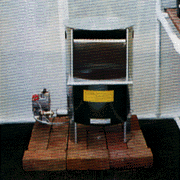|
|
|||||||||||||||||||||||||||||||||||||||||||||||||||||||||||||||||||||||||||||||||||||||||||||||||||||||||||||||||||||||||||
|

How
Many BTU Do You Need? Here Is A Tip!
Multiply the width x the length of
your greenhouse, this equals the sq/ft. Multiply the sq/ft by 77.
The result is approximately how many BTU you need to operate your greenhouse.
HEATING GREENHOUSES
Many types of heaters and heating systems are satisfactory for greenhouses. You must decide which system best suits your greenhouse operation. Consider the initial cost, economy of operation, and available fuel. You can heat your greenhouse efficiently with coal, electricity, gas, and oil. Heating equipment can be a space heater, a forced air heater, a hot-water or steam system, or electric heaters. Radiant heat lamps over plants and soil cables under plants can also be used.
The capacity of your system will depend on the size of your greenhouse, whether it is covered with a single layer or a double layer of plastic or glass, and the maximum difference between inside and out- side temperatures. Heat systems are rated in British thermal units (BTU) per hour. The firm from which you buy your greenhouse can tell you what size of heater you will need; or you can estimate the size as follows:
•First, find the temperature difference. This is the difference in degrees Fahrenheit between the lowest outside temperature and the temperature you want to maintain inside your greenhouse. For instance, if you want to maintain a minimum inside temperature of 60 degrees and the coldest night temperature you expect is -10 degrees, your temperature difference is 70 degrees
•Next, find the number of square feet of exposed glass or plastic in your greenhouse. Don't forget to add the areas of the sides and ends to the area of the roof.
•Multiply the temperature difference by the number of square feet. For example, suppose you have a 20 x 100 foot greenhouse with a total of 3,400 square feet of exposed plastic. You would multiply 3,400 by 70 (the temperature difference). This would give you 238,000.
•Now, if your greenhouse is covered with 2 layers of plastic or glass, multiply the 238,000 by 0.8. If it is covered with only 1 layer, multiply by 1.2. This will give you the required BTU per hour capacity of your heater.
In the example, a 2-layer greenhouse would be: 238,000 x 0.8 = 190,400 BTU per hour. The 1-layer greenhouse would be: 238,000 x 1.2 = 285,600 BTU per hour.
|
BTU Quick Grid |
||||||
|
Temp Rise |
Greenhouse size |
|||||
|
4x8 |
6x4 |
6x8 |
6x12 |
8x12 |
8x16 |
|
|
5 |
682.5 |
710.5 |
952 |
1228.5 |
1379 |
1648.5 |
|
10 |
1365 |
1421 |
1904 |
2457 |
2758 |
3297 |
|
15 |
2047.5 |
2131.5 |
2856 |
3685.5 |
4137 |
4945.5 |
|
20 |
2730 |
2842 |
3808 |
4914 |
5516 |
6594 |
|
25 |
3412.5 |
3552.5 |
4760 |
6142.5 |
6895 |
8242.5 |
|
30 |
4095 |
4263 |
5712 |
7371 |
8274 |
9891 |
|
35 |
4777.5 |
4973.5 |
6664 |
8599.5 |
9653 |
11539.5 |
|
40 |
5460 |
5684 |
7616 |
9828 |
11032 |
13188 |
|
45 |
6142.5 |
6394.5 |
8568 |
11056.5 |
12411 |
14836.5 |
|
50 |
6825 |
7105 |
9520 |
12285 |
13790 |
16485 |
|
55 |
7507.5 |
7815.5 |
10472 |
13513.5 |
15169 |
18133.5 |
|
60 |
8190 |
8526 |
11424 |
14742 |
19782 |
|
|
65 |
8872.5 |
9236.5 |
12376 |
15970.5 |
17927 |
21430.5 |
|
70 |
9555 |
9947 |
13328 |
17199 |
19306 |
23079 |
The type of system you choose will depend on how much you want to spend.
The four types are:
Space heaters - For low-cost heating for small greenhouses, use one or more ordinary space heaters.
WARNING: If you use a gas, oil or coal heater, be sure to have a fresh air supply to avoid carbon monoxide buildup due to restricted oxygen supply. Fans are also needed to improve circulation. Use high grade (low sulfur) kerosene to avoid sulfur dioxide damage; high ignition temperature to avoid carbon monoxide and ethylene buildup is important.
Forced-air heater - The best system for heating a small greenhouse is a forced-air furnace with a duct or plastic tube system to distribute heat. You can use a thermostat to control the temperature in the greenhouse.
Hot-water or steam heater - A hot-water system with circulator or a steam system linked with automatic ventilation will give adequate temperature control. In some areas, coal or natural gas is readily available at low cost. This fuel is ideal for hot-water or a central steam system. Steam has an advantage in that it can be used to sterilize growing beds and potting soils.
Electric heaters - Overhead infrared heating equipment combined with soil cable heat provides a localized plant environment, which allows plants to thrive even though the surrounding air is at a lower than normal temperature. Electric resistance-type heaters are used as space heaters or in a forced air system.
To Learn More About Planning Your Greenhouse Select Your Area of Interest by 'Clicking' on the Index Text Below.
TYPES OF GREENHOUSES & CONSTRUCTION
GREENHOUSE COLD FRAMES, HOTBEDS & PROPAGATING FRAMES
GREENHOUSE VENTILATION & COOLING
GREENHOUSE LIGHTING, TEMPERATURE AND CONTROL
HEATING GREENHOUSES AND OTHER ACCESSORIES
|
Copyright 2006, All Rights Reserved Including Page and Website "Look & Feel" |

"A Company with Products & Services to Enrich Your World"

